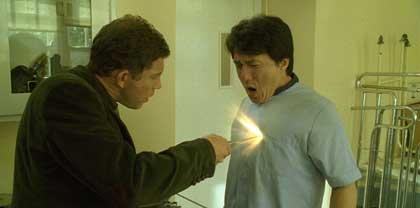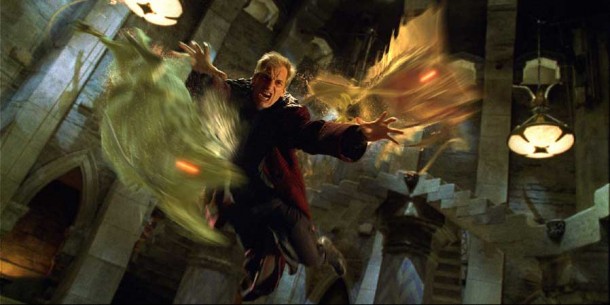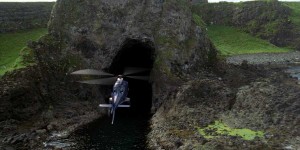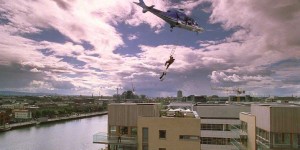“The Medallion”
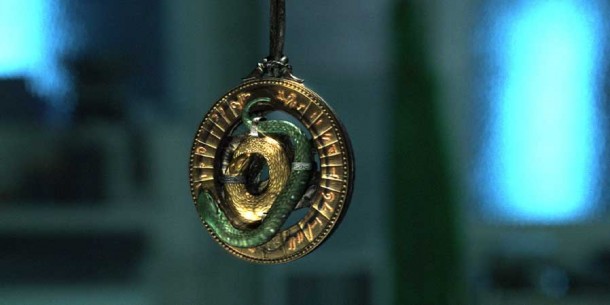
An Interview with Paddy Eason, VFX Supervisor at The Moving Picture Company
It could be said that Jackie Chan himself is a phenomenon of his own. He is able to perform stunts few other humans would even dare attempt. He is one of the few rare actors who actually does his own stunts. He is admired and revered by fans all over the world.
But when teamed-up with some of the top VFX men and women from London (No, we’re not talking about Agent 007 here), nothing can possibly stop them. Paddy Eason from The Moving Picture Company tells us about their dangerous mission that brought them to the four corners of the globe (probably traveled more than 007 in this mission anyway), overcoming many language and cultural barriers to deliver some spectacular stunt work and Visual FX for the box office hit, The Medallion.
CGC: Could you begin by telling us about yourself?
PE: My name is Paddy Eason, and I work for the Moving Picture Company in London as a digital visual effects supervisor. I’ve been here about 2 and a half years. I’ve been in the industry doing one thing or another about 13 years.
CGC: What brought you to the crazy world of visual effects in the first place?
PE: Well, it does seem sometimes as if it is by accident, but I did do computer graphics and fine art at university. And before that, I was always interested in photography. But in terms of getting into the business, I think I was lucky enough to be in the right place at the right time. Things were pretty small and low key then, and you could kind of wander in as a trainee, and work your way up through a company. I think it’s much more structured now, which actually I think is a pity.
CGC: Your credentials are impressive, Harry Potter and the Sorcerer’s Stone, Enemy at the Gates, Mission Impossible I & II and Chicken Run to name a few, how did your experience in the industry prepare you for this project?
PE: Nothing can prepare you for a project like this. It was a one-off, and I expect never to work on anything like this again. I got to work with people from the film industries of England, Ireland, Hong Kong, Thailand and the U.S… I learned a lot, but it was quite a heavy trip.
CGC: Can you give us a detailed breakdown of the shots you created for the film?
PE: We had about 650, of which we understand around 450 ended up in the final cut (which we haven’t seen yet!). There was a wide mixture of VFX work in there. There were, of course, and lot of wire and rig removals to aid the stunt work. And general VFX enhancements like muzzle-flashes, scratch removals, speed changes, adding motion blur, some blue screens and so on. Then there were the more creative 2D-based VFX, generally to add some kind of “magic” to shots…
…And finally we had a range of 3D stuff – tumbling shipping containers, a helicopter, the glowing, magically dissolving bodies and the full-on magic creature work.
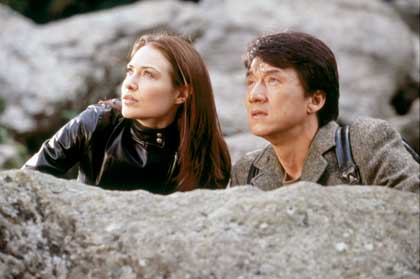
Photo: Actress Claire Forlani (left) and Jackie Chan (right)
PHOTO CREDITS: Chan Kam Tsuen
2003 Golden Port Productions Limited. All Rights Reserved.
CGC: Tell us about the different “Magical Effects” you created, did you develop some sort of formula or were each individual shots different solutions?
PE: A lot of them were about lighting. There is a kind of signature magic light that reoccurs thought the film. It’s kind of an old-fashioned look in a way, but we tried to make it as classy as we could. We see it emanating from the medallion when it’s doing its magical thing. We see it coming from bullet holes and stab wounds in “Highbinder” people. And we see it at the finale when the final fight comes to a climax.
CGC: What are “highbinder” people and what do you mean by “signature magic light”?
PE: There are two characters in the film that die and are brought back to life with enhanced powers. These people are called “Highbinders”. They don’t actually look any different, but they can run superfast, jump over things, they don’t get killed by bullets – that kind of thing.
At various significant points in the movie, things glow and emit a magical light. This happens to the medallion itself, to people when they are in the process of transformation, and also when certain characters are injured, for example, by bullets. Normally the key to getting good-looking lighting effects is to shoot the scene with carefully set-up interactive light falling on people and objects in the scene. This really helps the lighting effect “sit in” to the shot, rather than just looking stuck on. Unfortuately because of the nature of the shoot, we were only able to do that in a few cases, so we had to add interactive light as part of the compositing.
CGC: Could you tell us more about the “magic light effects” and how you achieved this effect?
PE: We used a mixture of 2D and 3D effects. When we really needed to do volumetrics, with shadow interaction and so on, then we did it in 3D, with our own implementation of “deep shadows” (this was before Renderman included it). But we quickly found that in most cases it could be better creatively and also quicker to handle it in 2D with radial blurs and so on. The basic element which we treated and radial-blurred and used for the magic light effects was actually some hand-held DV footage of lights reflecting in the surface of Hong Kong Harbor which I filmed during an idle moment on one of the many night shoots. The real secret of getting these kind of light effects to look good is working with an extended dynamic brightness range when you composite.
CGC: Could you give us more detail on what you exactly mean?
PE: Well, any compositing package allows you to take an image and apply a directional blur radiating from a central point. You see it all the time with flying logos. It’s a cheap trick, but it still has a certain coolness. We made most of the light effects by running an image (of light reflecting on water) through this radial blur, and then using this as a matte to composite light onto the shots. As long as you spend the time finessing the shot to get the right balance of brightnesses, colours, interactive light and so on, it can look very nice.
CGC: Tell us about the sequence where Eddie Yang (Jackie Chan) dissolves on screen?
PE: Those two shots took far longer than anything else. But we were quite happy with the final result. What we see is Jackie’s character’s body, as it lies on a mortuary slab, beginning to glow with internal light, which bleeds through the eyelids and nostrils. Just as we become aware of a few wisps of smoke coming from behind his head, the glow breaks through the skin, and his whole face and head break apart into glowing ash, which floats up and away. As the sequence finishes, the frame is flooded with heavenly light, within which we just see a hint of skeletal structure. The starting point for us was two things – the photographed plate of Jackie on the table (we also had a clean plate) and also a good CG model of Jackie.
We then projected the plate onto the Cyberscan geometry. A pretty heavy and complex particle system was built by our lead TD Matt Gidney to allow skin particles to change color and then detach from the skin and fly up. When the skin broke open it allowed volumetric light rays to shine through. It was mainly the interaction between volumetric lighting and particles that took the time, along with a lot of 2D finessing by the composite supervisor Angela Barson.
CGC: How did you create the digital double you created of Jackie Chan?
PE: We had a good cyber scan of Jackie’s head and shoulders – in fact, the cyber scan people were very impressed with Jackie’s ability to stay still during the scan – they never seen anyone be able to do it so well! I guess that it’s just another manifestation of Jackie’s physical skill and discipline. There are no digital doubles of Jackie elsewhere in the movie – all the action was shot in-camera.
CGC: What 3D tools did you use here?
PE: Maya, Renderman and some proprietary tools.
CGC: For which reasons did you have to use proprietary tools? Are you mainly referring to custom shaders or anything else?
PE: We have a number of custom Shake plug-ins for compositing – little things that make life easier, but which don’t come as standard with the package. And on the 3D side, we did use custom shaders (for example, the deep shadows solution for the heavenly light in the final fight scene) but as a whole it was 95% standard Maya and Renderman. Most of the proprietary software we have acts as “glue” to stick different parts of the pipeline together. Solutions for dealing elegantly with things like colourspace, particle dynamics, shadow interation and so on.
CGC: How did you create the different effects where the Medallion comes to life?
PE: The medallion itself was modeled in 3D two different ways – once as a full rigged version, for shots where the little creatures needs to swim around and move, and a more basic scanned model where we just needed it to fly through the air, and glow etc. The “hero shot” where the creatures come to life in the medallion was animated by our CG supervisor Lars Johansson. We wanted the creatures to really look like they were part of the metallic jewelry, and I think that we got a good balance between the magic of the creatures’ movement and the realism of the rendering.
CGC: What do you mean by “Hero Shot”?
PE: When we refer to a “hero shot”, this means a shot in a vfx sequence, where the vfx are central to the shot. It’s our chance to show off.
CGC: Did working in different locations around the world create any specific challenges for you?
PE: Well it’s the first time I had to be away from home working for such a long time (about 6 months away, 3 or 4 months at a stretch), and as I have a young son, that wasn’t ideal. We (myself, Merrin Jensen our VFX producer and Lars Johansson, our CG supervisor) lived and worked in Dublin, Bangkok and various other parts of Thailand, Hong Kong and then finally back to London.
Language was the main problem. It’s very hard to be on top of what is going on a film set when you can’t understand the majority of what anyone is saying. Especially when things are as fast-flowing and improvisational as they are on Hong Kong movies. And then there are the cultural differences. I have to say that I found Hong Kong a difficult place to work. The crews seem very boss-orientated – only the top chief of a department seems really allowed to make any decisions, and things seem to be run on a need-to-know basis. There’s often a degree of mistrust of digital VFX on film sets, and this was certainly the case here.
Also there seemed a great reluctance to do much detailed forward-planning. The H.K. tradition of on-set stunt improvisation was working against us in that regard. For complex vfx you really need to work out your options in detail beforehand, and we simply weren’t able to do that. So in the end, I feel we couldn’t offer any real clever stuff to enhance the action and the camera work – it was all much more basic.
CGC: In the film industry, Jackie Chan is a rather unique character. You could almost say that he is by himself a “visual effects” with all the moves that he is able to accomplish. This must create some rather unique and interesting situations?
PE: Well in this movie he does do more wire work than he has before, and I think that’s a mixed blessing. I think that to get a wire stunt to look acceptable (to a western audience in particular), the physics of the movement has to be credible, and that is very hard. Of course it’s also hard to get the physics of CG superhero-type action to be credible – there’s definitely a point where the audience switches off, when they realize that there is absolutely no way that guy could have jumped from the top of that building to the street without having broken every bone in his body.
I should stress, in contradiction to what some people have been saying about this movie, there is no CGI stunt-work at all. It’s all physical stunt action, wires etc.
CGC: Do you mean that the digital double of Jacki Chan was only used for the dissolve scene?
PE: Yes. There are a few bluescreen stunts as well – the scene where Jackie falls from the 8th floor of an apartment block, a stunt in the castle where it was really impossible to get the wires rigged and so on, but the overwhelming majority of the stunt work is all in-camera, no vfx or CGI at all.
CGC: How difficult were the integration of the CG elements with the live plates?
PE: For the more prosaic stuff like the helicopter, the shipping container and even the CG medallions and so on, it wasn’t too hard. We just follow normal lighting, shading and compositing practices, and the final result should be convincing.
For the magical stuff, in particular the creatures and the heavenly light at the end, there was definitely a creative and technical challenge! We needed the creatures to look otherworldly, yet physically in the scene. A lot of that was down to the atmospheric stuff – a lot of fiery particles, some nice volumetric light effects and so on. We built a fairly accurate and detained CG model of the whole castle-interior set, and used it to relight the set in CG. This meant was could have the light shine out onto the walls of the set, and to have the creatures and the particles cast shadows on the set etc. It’s not something you should notice, but it does help it all integrate nicely.
CGC: What is your proudest achievement in this film?
PE: Still being there at the end! Seriously – by the end of the project it was well over 2 years since the first meeting, and over the months the personnel in practically every department changed for all kinds of reasons, until we were pretty well the only guys who had been there from the start. I think that at least shows commitment!
I quite like the way we did the second “dissolving body” shot. The first time we see the effect – with Jackie’s body in the morgue – we did the full-on CG solution which looks great, but was very time consuming and expensive. I wanted to do something a lot lighter and easier with the second occurrence of this, when Snakehead blows his own dead body away into dust. So we just shot the scene with Julian Sands blowing a pile of sawdust at the camera, and it looked great! There was quite a lot of tricky paintwork to be done (carried out admirably by Christian Zeh) but it was still a lot easier than doing it all in CG.
I also like the fact that the climactic scene with the medallion, the magic exploding antler, the attack dragon and fish and the heavenly light explosion, (which was worked out between the director, the stunt director and Jackie literally over lunch on the day before we started shooting it,) was able to be realized and completed at all. I think that this shows that even we over-meticulous, strait-laced western guys can learn to work “Hong Kong style”…
CGC: What is your next project?
PE: We’re deep into the VFX work on Harry Potter and the Prisoner of Azkeban, Troy (starring Brad Pitt) and Big Fish. Everything is worked out and planned meticulously and it’s going to be great.
Big thanks to all who made this story possible and especially the kind people at The Moving Picture Company who did everything they could to give us the most detailed answers imaginable.
Related Links:
The Moving Picture Company´s home-page
All pictures featured in this article are the property of Tristar Pictures and all their respective owners.

